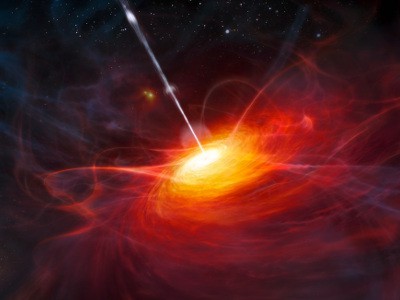

Astrophysicists at the Carnegie Institution for Science in Pasadena, California, have identified a record 63 new quasars that were formed when the universe was just one billion years old. The findings amount to the largest discovery of ancient quasars presented in one scientific study and almost doubles the number of known ancient quasars.
Quasars are ever-growing supermassive black holes formed at the centre of major galaxies. Their gravitational forces are so strong that they gobble up stars and surrounding matter, forming an accretion disk and in the process heating up the gases orbiting them to such an extent that they produce the brightest lights in the universe – billions of times brighter than our Sun. Most known quasars are at quite a distance from us, billions of light years, in fact. Thus in observing quasars from here on Earth, scientists are effectively looking at light emitted from these objects as they existed billions of years ago.
“Quasars are among the brightest objects and they literally illuminate our knowledge of the early universe,” says Eduardo Bañados, Carnegie-Princeton fellow at the Carnegie Observatories and lead author of the new study to be published in the Astrophysical Journal Supplement Series.
One of the mysteries surrounding the early days of the universe concerns the reionization of the cosmos when roughly between 150,000 million and one billion years after the Big Bang occurred, the first stars began to give off quantities of radiation large enough to turn neutral hydrogen back into ionized, molecular hydrogen. How exactly the huge amount of radiation was created to accomplish this feat is still unclear, but scientists are counting on this new batch of ancient quasars to provide some new insight.
“The formation and evolution of the earliest light sources and structures in the universe is one of the greatest mysteries in astronomy,” says Bañados. “Very bright quasars such as the 63 discovered in this study are the best tools for helping us probe the early universe. But until now, conclusive results have been limited by the very small sample size of ancient quasars.”
A study released earlier this year by researchers from York University in Toronto provided further clues into the nature of quasars, showing that the intense heat and light produced by some quasars can force matter to be expelled into the surrounding region at incredible speeds, causing ultraviolet winds that travel upwards of 200 million kilometres an hour. “We’re talking wind speeds of 20 per cent the speed of light,” says Jesse Rogerson, PhD candidate in the Department of Physics and Astronomy at York University and lead author of the study.
Using data from the twin telescopes at the Gemini Observatories in Hawaii and Chile, the team was able to confirm the fastest quasar winds ever-recorded. “Quasar winds play an important role in galaxy formation,” says Rogerson. “When galaxies form, these winds fling material outwards and deter the creation of stars. If such winds didn’t exist or were less powerful, we would see far more stars in big galaxies than we actually do.”
Leave a Reply
You must be logged in to post a comment.




 Share
Share Tweet
Tweet Share
Share




Comment